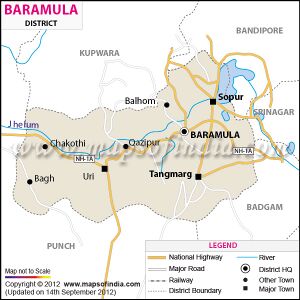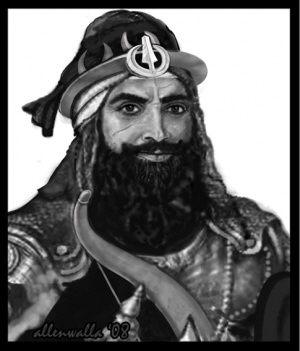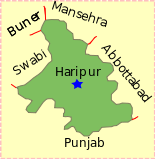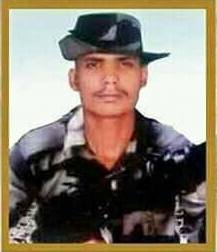Uri Baramulla
| Author:Laxman Burdak, IFS (R) |


Uri (उड़ी) is a town and tehsil in Baramulla district in Indian union territory of Jammu and Kashmir.
Location
Uri is located on the left bank of the Jhelum River, about 10 km east of the Line of Control with Pakistan. Uri, a beautiful town situated on the left bank of Jehlum river is about 23 miles from Baramulla. Uri is located at the entrance to the Kashmir Valley from the west, lying on the Jhelum Valley Road.[1]Prior to the partition of Kashmir, the road linked Uri to Rawalpindi and Srinagar. Another important road linked Uri to Poonch via the Haji Pir pass. Uri is at a distance of 76 122 km from Srinagar, 42 68 km from Muzaffarabad and 49 79 km from Poonch. [2]
Origin
- Uri was Ouri (Udder of Cow).
Tourism
Villages in Uri tahsil
Town: 1 Uri,
Villages: 1 Addosa, 2 Badan, 3 Bal Koote, 4 Balgran, 5 Bandi, 6 Basgran, 7 Chakra, 8 Chapper, 9 Chollan Kalsan, 10 Churanda, 11 Dachi, 12 Darah Gutliyan, 13 Dardkote, 14 Dhani Saidan, 15 Dulanja, 16 Dwaran, 17 Gavalata, 18 Ghar Kote, 19 Gingal , 20 Gohallan, 21 Hardu Kamal Koote, 22 Hathlanga, 23 Isham, 24 Jablah, 25 Kandi Barjala, 26 Nambla, 27 Nawa Rundan, 28 Now Pora, 29 Paran Pilan, 30 Ramgal, 31 Sahoora, 32 Said Pura, 33 Salam Abad , 34 Salli Koot, 35 Shadara, 36 Sukhdar, 37 Sultan Daki, 38 Thajal, 39 Tulwari, 40 Uri, 41 Zamboor,
Source - https://www.census2011.co.in/data/subdistrict/37-uri-baramula-jammu-and-kashmir.html
Jat clans
History
Source - K. D. Mani, Uri: The historical town, Daily Excelsior, 6 November 2017.
Uri township has a glorious past and was known as ‘window of Kashmir’ due to its location.
Hari Singh Nalwa (r. 1820–1823), the Jat Sikh commander-administrator of Ranjit Singh, built the fort of Uri.[3]
Following the First Anglo-Sikh War (1845–1846) and the Treaty of Amritsar (1846), Raja Gulab Singh was proclaimed the Maharaja of Jammu and Kashmir, acquiring all the lands between the Ravi River and the Indus. [4]
K. D. Mani[5] writes....Before partition , Jhelum valley road linking Srinagar with Koh-Mari – Rawalpindi via Muzaffarabad enters into Kashmir valley from this very town. Another important road from Uri leading towards Poonch principality via Haji Pir Pass (8600') also branched off from this township. This town 76 miles away from Srinagar, 42 miles from Muzaffarabad and 49 miles from Poonch town. Therefore, Uri was a halting station and transit camp for the passengers and tourists coming from outside to visit Kashmir. Uri was resort for traders who were exporting wild honey, wild mushroom, handmade blankets and walnut to Rawalpindi.
Raja Nazar Boniharvi writes in one of his articles that the original name of Uri was Ouri (Udder of Cow). This name was given by a hermit who had meditated at this very place. With the passage of time the name changed from Ouri to Uri. As per the first settlement report of Uri, before independence Uri was a tehsil of Muzaffarabad district .This Tehsil was separated from Karnah and Muzaffarabad by Daburdun (11553)’ and Qazi Nag (13437)’ hills while Neel Kanth (12330)’ and Haji Pir Pass (8600 feets above the sea level) were bifurcating Uri from Poonch principality.
Uri falls at the last edge of Pir Panchal region which ends at Muzaffarabad. Tehsil Uri is located on the right flank of river Jhelum and known as Dachhan Para (i.e. the old Kathai and Duppta Jagirs) while the area on the left flank of Jhelum was known as Khadra Para (i.e.Uri, Kachhali and Chakar). More than 50 percent population belonged to Pahari tribes who were the ruling class from ancient time. The remaining population comprised of Gujjar and Bakarwal tribes apart from some of Kashmiri speaking people.
There are a number of shrines in Uri .The main Shrine is of Hazarat Pir Gaffor Shah Sahib located in the village Perian.The important Shrines are the zariat of Pir Masoom Shah Gazi in Kamalkote and Zariat of Hazarat Baba Farid in Gharkote.
There are some ancient monuments of Pandavas time in Uri like Datta Mandhir in Rajarwani and Pandav Temple in Boniar.
There is also a Sikh Shrine known as Gurudwara Chati Padshai in the village Peran Pella across river Jhelum near Lagama.
Uri is known for the biggest walnut market of Kashmir valley. The walnut mandi is established at Lagama.The traders from all over the country assemble at this place for the purchase of walnuts. Two main hydle projects in Uri have shown good impact on the economic condition of the people of this area. Uri has once again assumed limelight in view of opening of Srinagar Muzaffarabad road. It is expected that with the opening of this window the old glory of Uri Township shall be restored.
Uri-Kathai area was a part of Muzaffarabad principality which was established by Sultan Muzaffar Khan Bamba in 1644 AD. Later on, this track was governed by Khakhas, Hatmales and Bamba Pahari tribes who were the chiefs of small Jagirs like Uri, Kachalli, Chakar, Duppta and Ghori. These warrior tribes had played a great role during Afgan rule (1753-1819) on Kashmir, because the main route connecting Srinagar with Kabul was passing through this track. Khakas of Uri had became instrumental in defending Kashmir from the invaders a number of times Raja Bara Khan Khakha, Raja Sarblund Khan Khakha, Raja Bhadur Khan Khakha and Raja Sarfraz Khan Khakha were the important rulers of Uri during Afgan rule on Kashmir. At the time of conquest of Kashmir by Maharaja Ranjit Singh in 1819 Raja Ghulam Ali Khakha was the chief of Uri principality. He was not satisfied by the Khalsa Sarkar and had revolted against Punjab Government. Therefore in 1820 Maharaja Ranjit Singh appointed Hari Singh Nalwah as Governor of Kashmir to subside the disturbance in Uri and Muzaffarabad areas. Hari Singh Nalwah with the help of Raja Muzaffar Khan (who was nephew of Raja Ghulam Ali Khan Khakah) crushed the revolt of Khakhas and Bambas of Uri and Muzaffarabad areas during 1820-1821 .Raja Ghulam Ali Khakha , the ruler of Uri was arrested and later on killed in Sher Ghari prison of Srinagar.
C E Bats writes in his book ‘The Gazetteer of Kashmir’ that Hari Singh Nalwah had appointed Raja Muzzaffar Khan as the Chief of Uri on behalf of Khalsa Government on consideration of annual payment of rupees four thousand . No doubt that Muzzaffar Khan was called Raja of Uri but the actual power was lying with the administrators of Khalsa Sarkar who were ruling the area. B C Hugal the writer of ‘Kashmir and Punjab’ who visited Uri during 1841 writes that after Sikh rule in Kashmir, the Uri track was partitioned into small Jagirs. After 1846 when Ghulab Singh became the Maharaja of Jammu and Kashmir, Uri emerged as a tehsil of Muzaffarabad Wazarat.
During the happenings of 1947, Uri witnessed a great setback due to attack of raiders, immediately after independence. Pakistan started operation Gulmarg to capture Kashmir valley by inducting tribesman of NWFB and Pakistani forces under the command of Khursheed Anwar (a retired soldier of Indian Army) and overall supervision of Major General Akber Khan of Pakistan Army. The first group of tribesman moved towards Uri on 23rd November 1947. On the other hand Brigadier Rajinder Singh officiating Chief of staff of J&K forces with 150 Jawans rushed towards Uri and reached the same day by midnight to defend Uri town from raiders. Rajinder Singh was born on 14 June 1899 in Bagoona village (now Rajinderpura, Samba district) in a military Dogra family.[6] His ancestor General Baj Singh had died serving under Maharaja Gulab Singh. His grandfather Hamir Singh and father Subedar Lakha Singh were both war veterans.
The raiders started wave after wave attack on Uri from all the sides. Therefore, after fighting of several hours, the defenders retreated from Uri to Muhra during the night of 23 and 24 October 1947. The raiders chased the small contingent of Brigadier Rajinder Singh and fighting continued on 24th October. In this battle the gallant band fought bravely in which almost all the jawans along with Brigadier Rajinder Singh were killed but he and his men held up thousands of raiders for four most valueable days and thus undoubtedly saved Kashmir. On 26th October Kashmir acceded to India and from 27th October Indian forces started pouring at Budgam airport to defend Kashmir. After consolidating their positions at Srinagar, Indian forces launched operation against raiders and captured Baramulla on 8th November. While Uri town was liberated on 13th November, 1947 after hand to hand battle with raiders, the outer hills around Uri were also taken by Indian forces in further fighting with raiders.
During the happenings of 1947 more than 50 percent area of tehsil had gone under the occupation of Pakistan. The present Uri tehsil has been squeezed up to Nowshera in the east, Urasha in the North, Sailkote in the south and Buttgharian in the west .The portion of Uri on the other side of the line of control is known as tehsil Hattari Bala.
During 1965 Uri again became the focal point for Army operation when the Indian forces under the command of Brigadier Zorawar Chand Bakshi launched operation against infiltrators from Uri towards Haji Pir Pass on 24 August, the Indian jawans under the command of Major Ranjit Singh Dayal captured Haji Pir Pass on 28th of August and moved towards Poonch .Ultimately, Uri Poonch Bulge was taken over by the Indian forces and the road from Uri to Poonch was once again opened and Uri area got relief from day to day firing. However this prestigious pass and the life line of Kashmir was returned to Pakistan in the light of Tashkand Pact.
Jat History


Sardar Hari Singh Nalwa (1791-20.4.1837[7]) (हरीसिंह नलुआ), the great Utpal/Uppal gotra Jat warrior was born at Gujranwala and was the Commander-in-chief of Maharaja Ranjit Singh. His father was a warrior in Maharaja Ranjit Singh's army. Sir Henry Griffin called Nalwa the "Murat of the Khalsa".
The Conquests of Hari Singh Nalwa: In 1816, Tits and Bits wrote an editorial piece in Britain, in which it was asserted that had Nalwa the resources and the artillery of the British, he would have conquered the East entirely. This most famous of the great Sikh generals can count the following conquests: Kasur (1807), Sialkot, Kashmir (1814), Multan (1818), Peshawar (1827). He held Kashmir and Peshawar as its governor in 1834. Nalwa was the only person whose name was minted on the currency of Punjab; today the Hari Singh rupee can be found in museums in India. He died on 20 April 1837 in war with Peshawar.[8]
Hari Singh earned the name 'Nalwa' after he killed a tiger, as Baron Hugel, a European traveller writes in "Travels in Kashmir & the Punjab: " I surprised him by knowledge whence he had gained the appellation of Nalwa, and of his having cloven the head of a tiger, who had already seized him as its prey. He told the Diwan to bring some drawings and gave me his portrait, in the act of killing the beast."
Nalwa was dishonourably murdered in an ambush from behind. It is believed that two Dogras that were in Maharaja Ranjit Singh's cabinet (secretly in the pay of the British and the Afghans) were behind the attack. An undelivered letter to the Maharajah asking for assistance from Nalwa was later found in the possession of one of these Dogras. Bibi Harshan Kaur then made her much heralded walk of valour from Jamrud to Peshawar carrying news that Jamrud was under attack, but it was too late for Nalwa. He died when 60,000 troops attacked his fort. The sikhs told him that they were about to attack as they thought he had died however he was still alive. He then went on to the balcony and rested his Teer (arrow) in to his ear and died whilst the fight was on. Just seeing Hari Singh was enough to scare the forces away who trampled their own people.
Haripur in Hazara Division in the North-West Frontier Province of Pakistan is named after Hari Singh Nalwa.

Major General Swarup Singh Kalaan -
Major General Swarup Singh Kalaan (Jakhar) was born on 16th November, 1912 in village Salhawas, Jhajjar district, Haryana. He was the son of Rai Sahib Sultan Singh, a police officer.
Major General Kalaan received his education at Jat High School, Hissar, Anglo Sanskrit High School, Ambala City, Government College, Rohtak and St Stephen College, Delhi. He joined the 319 Jat Regiment as a Y. Cadet and from there rose to the rank of Major General. He was awarded the Military Cross (MC) during World War II. He was also awarded Maha Vir Chakra (MVC) for his courage in the 1965 India-Pakistan War and retired from the Indian Army in 1966.
1965 Indo-Pakistan War ....
During this war, Major General Swarup Singh Kalaan was in command of the 19 Infantry Division in the Uri-Baramula-Gulmarg Sector. The first report of Pakistani infiltration was received in his area. He planned and executed operations to hunt the infiltrators, capture their bases and block routes of infiltration. In order to capture the Hajipur Pass and the subsequent link-up towards Poonch, he himself led his troops against the well entrenched Pakistan Army posts. They managed to throw out the enemy from their well guarded positions. He succeeded in his mission by showing exemplary leadership, determination and courage in the best traditions of the Indian Army. He was awarded the Maha Vir Chakra (MVC) on 5th August, 1965. [9]

Naik Nand Singh: Nand Singh VC & MVC (24 September 1914 – 12 December 1947) was an Indian recipient of the Victoria Cross,[10] the highest and most prestigious award for gallantry in the face of the enemy that can be awarded to British and Commonwealth forces.
He was 29 years old, and an Acting Naik in the 1/11th Sikh Regiment, in the Indian Army during World War II when the following deed took place for which he was awarded the VC.
On 11/12 March 1944 on the Maungdaw-Buthidaung Road, Burma (now Myanmar), Naik Nand Singh, commanding a leading section of the attack, was ordered to recapture a position gained by the enemy. He led his section up a very steep knife-edged ridge under very heavy machine-gun and rifle fire and although wounded in the thigh, captured the first trench. He then crawled forward alone and, wounded again in the face and shoulder, nevertheless captured the second and third trenches.
He later achieved the rank of Jemadar in the post-independence Indian Army, and his unit 1-Sikh was the first to be involved in the Jammu & Kashmir Operations or Indo-Pakistani War of 1947 which began in October 1947 as Indian troops went into action to repel a planned invasion of J&K by raiders from Pakistan.
On 12 December 1947 Nand Singh led his platoon of D Coy in a desperate but successful attack to extricate his battalion from an ambush in the hills SE of Uri in Kashmir. He was mortally injured by a close-quarters machine-gun burst, and posthumously awarded the Maha Vir Chakra(MVC), the second-highest Indian decoration for battlefield gallantry. This makes Nand Singh unique in the annals of VC winners. The Pakistanis recognised Singh because of his VC ribbon. His body was taken Muzaffarabad where it was tied spreadeagled on a truck and paraded through the city with a loudspeaker proclaiming that this would be the fate of every Indian VC. The soldier’s body was later thrown into a garbage dump, and was never recovered.
Singh belonged to Village Bahadurpur now in district - Mansa, Punjab. A bus stand in town Bareta Shaheed Nand Singh Viktoria Bus Stand is named in his memory. A statue has also been established in Bathinda (locally known as Fauji Chowck) as a memorial for the great warrior.

Nitin Chaudhary (23) - From Dhanoura, Bulandshahr, Martyr of militancy on 29.5.2017 in Uri sector of Jammu and Kashmir, 17 Jat Regiment.
External Links
References
- ↑ Dasgupta, C. (2014) [first published 2002], War and Diplomacy in Kashmir, 1947-48, SAGE Publications, ISBN 978-81-321-1795-7,p.64
- ↑ K. D. Mani, Uri: The historical town, Daily Excelsior, 6 November 2017.
- ↑ 1. Bansal, Bobby Singh (2015), Remnants of the Sikh Empire: Historical Sikh Monuments in India & Pakistan, Hay House, Inc, p. 174, ISBN 978-93-84544-93-5; 2. Lone, F. A. (2005), The Exploration Of Uri Sector: Kashmir Valley, Shipra Publications, p. 42, ISBN 978-81-7541-222-4
- ↑ Singh, Bawa Satinder (1971), "Raja Gulab Singh's Role in the First Anglo-Sikh War", Modern Asian Studies, 5 (1): 51–52,
- ↑ K. D. Mani, Uri: The historical town, Daily Excelsior, 6 November 2017.
- ↑ Jamwal, Ayushman (15 August 2016). "The 1947 War Hero Who Sacrificed His Life For Kashmir". TheQuint. Retrieved 21 August 2020. Service, Tribune News. "Brig Rajinder Singh among greatest Dogra warriors: MLC". Tribuneindia News Service.
- ↑ Jat History Thakur Deshraj/Chapter VII Part I (i),p.273
- ↑ Jat History Thakur Deshraj/Chapter VII Part I (i),p.273
- ↑ Ram Sarup Joon:History of the Jats/Chapter XIII,p.242
- ↑ "The Victoria Cross Society"

